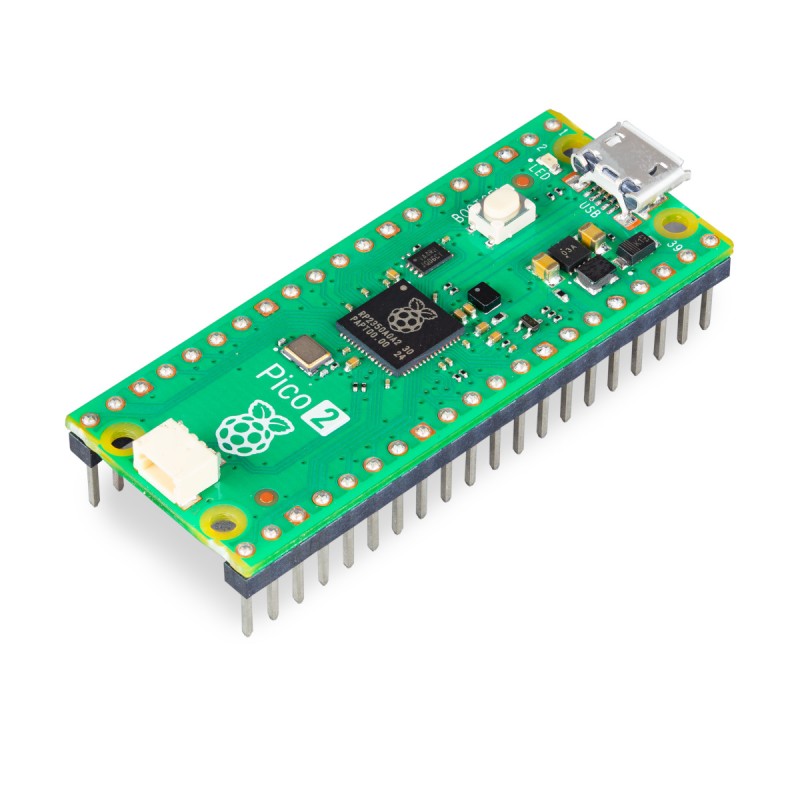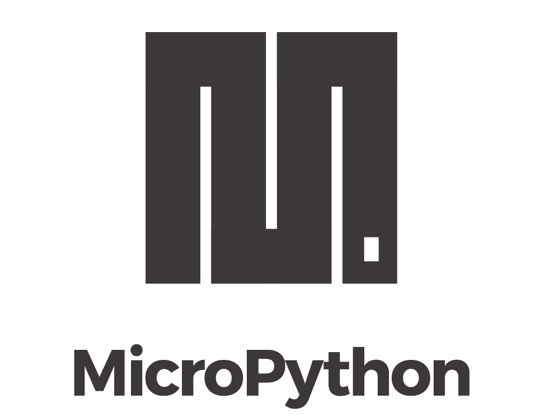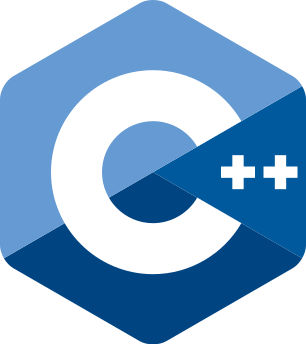



zł23.62 tax excl.
Raspberry Pi Pico 2 H, based on the RP2350 microcontroller, using the application and functional applications of the Cortex M33 and RISC-V cores, doubled SRAM memory and advanced security function, including Arm TrustZone. It is hardware and software with a connected model, which provides an attractive operation for enthusiasts and specialists in systems used. Version with joints.
Raspberry Pi Pico 2 H is a development board based on the RP2350 microcontroller, designed with high performance and security in mind. Compared to the previous version, Pi Pico 2 H is characterized by the use of Cortex M33 cores with a higher clock speed, two additional RISC-V cores, doubling the SRAM and memory. In addition, the second version of the iconic board introduces new security features and improved interface capabilities. Raspberry Pi Pico 2 H offers a significant increase in performance and functionality while maintaining hardware and software compatibility with earlier models of the Raspberry Pi Pico series. Version with joints.
The RP2350 system offers advanced security features based on Arm TrustZone for Cortex-M technology, including digitally signed boot, 8 KB of OTP antifuse memory for storing keys, SHA-256 acceleration, a hardware TRNG random number generator and fast error detectors. These features, along with the secure boot ROM, are well documented and available to all users, allowing professionals to seamlessly integrate the RP2350 and Raspberry Pi Pico 2 H into their projects.

Kamami is the official distributor of Raspberry Pi minicomputers and dedicated accessories.
| Raspberry Pi Pico | Raspberry Pi Pico 2 | |
|---|---|---|
| Microcontroller | RP2040 | RP2350 |
| Core | 2 x ARM Cortex M0+ 133 MHz |
2 x ARM Cortex M33 150 MHz 2 x RISC-V Hazard3 |
| RAM | 256 kB | 520 kB |
| Flash | 2 MB | 4 MB |
| Communication interfaces |
2 x SPI 2 x I2C 2 x UART 3 x 12-bit ADC 16 kanałów PWM 8 x PIO |
2 x SPI 2 x I2C 2 x UART 3 x 12-bit ADC 24 kanały PWM 12 x PIO |
| Programmer interface | USB 1.1 / SWD | USB 1.1 / SWD |
| Security features | - |
Arm TrustZone for Cortex-M Digitally signed boot |
| Supply voltage | 1,8 – 5,5 V | 1,8 – 5,5 V |
| Dimensions | 51 x 21 mm | 51 x 21 mm |

MicroPython is a special version of the Python 3 programming language, prepared to run directly on embedded systems such as the Raspberry Pi Pico. The version prepared especially for the RP2350 microcontroller, supports REPL, an interactive shell that allows you to execute scripts, typing into the console and viewing the results of the program in it. Thanks to this technology, it is also possible to save the program in flash memory.
To facilitate the programming of the RP2350 microcontroller in C / C ++, the Raspberry Pi Foundation has prepared an official SDK toolkit that can be integrated with popular IDEs such as Visual Studio Code or Eclipse. The entire environment configuration process is described in the Getting started with Raspberry Pi Pico document.


The Raspberry Pi Pico can be programmed via the USB interface, it can be done in two ways.
The first is the USB mass storage mode, to program the board in this way, press and hold the BOOTSEL button, and then connect the board to the computer with a USB cable. The device will be recognized as mass memory to which you can upload the program in the same way as copying files to a pendrive. After uploading the program, the microcontroller will automatically reset and start the uploaded program. This method is suitable for uploading programs written in C / C ++ or for uploading the MicroPython interpreter.
The second way works only with programs written in MicroPython and requires prior loading of the interpreter using the first method. This method consists in saving the program layout transferred with REPL in the memory.
When programming in C/C++, there is often a need to repeatedly test the program. Loading a program via USB requires repeating the procedure every time, disconnecting the board from the computer, pressing the button and connecting the board, and then finding the compiled program and copying it to memory. The whole thing takes quite a long time, but fortunately it can be simplified using an external programmer with SWD interface. Programming via SWD is much faster, you only need to connect the programmer once with a 3-pin connector and power supply e.g. via USB and you can upload programs directly from the IDE. In addition, you can debug the program in this way and efficiently find any errors in the code by running it line by line.
Warning!
The Raspberry Pi Pico board does not include a microUSB cable. 
Data sheet
Manufacturer BTC Korporacja sp. z o. o. Lwowska 5 05-120 Legionowo Poland sprzedaz@kamami.pl 22 767 36 20
Responsible person BTC Korporacja sp. z o. o. Lwowska 5 05-120 Legionowo Poland sprzedaz@kamami.pl 22 767 36 20
RP2350-Touch-AMOLED-1.43 is a high-performance platform for building modern user interfaces in mobile, wearable, and control system projects. The high-contrast AMOLED display and capacitive touch, combined with an IMU sensor and RTC, provide a comprehensive development environment for applications requiring advanced interaction and mobility.
Pimoroni Pico LiPo 2 XL W PIM776 is an extended development board with the RP2350B, offering Wi-Fi and Bluetooth connectivity, 16 MB of flash memory and 8 MB of PSRAM. Thanks to its 40 GPIO pins, integrated LiPo charging system and numerous interfaces, it works well in advanced IoT projects and battery-powered systems.
Pimoroni Tiny 2350 PIM766 in the Headered version is a compact development board with the RP2350A, 4 MB of flash memory and a USB-C connector, created for miniature projects. Thanks to the integrated pins, support for MicroPython and the Qw/ST port, it works well in prototyping portable devices and wearables.
Miniature KAmod RP2040 module with Raspberry RP2040 microcontroller and 16 MB flash memory provides high computing performance in a compact format. Suitable for educational, hobbyist, and prototyping applications of devices with USB, I2C, SPI, and UART communication.
Arduino development board with RP2040 microcontroller. Equipped with WiFi and Bluetooth module, 6-axis IMU system with accelerometer and gyroscope, MEMS microphone, RGB LED diode and cryptographic system. Arduino ABX00053
Module with LCD 2.4" display with a resolution of 320x240 px and RP2040 microcontroller. Equipped with QW/ST connector. Accessories included. Pimoroni PIM636
Raspberry Pi Pico 2W, based on the RP2350 microcontroller and has a built-in WiFi and Bluetooth communication module. Pi Pico 2W offers significantly increased performance and functionality thanks to the use of Cortex M33 and RISC-V cores, doubled SRAM memory and advanced security features, including Arm TrustZone. It is hardware and software compatible with previous models, making it an attractive choice for enthusiasts and professionals in the field of embedded systems
Development kit with RP2040 microcontroller equipped with two ARM Cortex-M0 + cores that work at 133 MHz, 264 kB RAM. The board has a QVGA camera, LCD display, IMU system and a microphone. ArduCAM B0302
No product available!
Board with RP2040 microcontroller and class D mono audio amplifier based on MAX98357 chip. It has a built-in LIS3DH three-axis accelerometer, an RGB NeoPixel LED, a LiPo charging circuit, and a STEMMA QT connector. Adafruit 5768
Compact development board based on the Raspberry Pi RP2350 microcontroller, equipped with two cores (ARM Cortex-M33 and Hazard3 RISC-V), 520KB RAM and 2MB Flash, ideal for IoT, smart home and wearable projects. With 11 IO pins, battery charging support, C/C++/MicroPython/Arduino programming and SMT support, it is perfect for rapid prototyping and mass production. DFRobot DFR1188
The board with the RP2040 microcontroller equipped with two ARM Cortex-M0+ cores, which work at a frequency of 133 MHz, 256 kB RAM. The board also has 8 MB of QSPI flash memory. The system can be programmed in C/C++ or MicroPython. Adafruit 4884
Board with RP2040 microcontroller and MCP2515 CAN controller. It has a built-in LiPo charging circuit and a STEMMA QT connector. It allows you to add communication based on the CAN bus to the project, commonly used in projects related to robotics and the automotive industry. Adafruit 5724
The board features the Raspberry Pi Foundation\'s RP2040 microcontroller and the WizFi360 module, which provides 2.4GHz WiFi communication over 802.11 b/g/n. WIZnet WizFi360-EVB-Pico
An enhanced version of the Raspberry Pi Pico 2 with access to all 48 GPIO pins and an RP2350B microcontroller (Cortex-M33 or RISC-V) clocked at up to 150 MHz. It offers 16 MB of Flash, 8 MB of RAM, and a microSD card reader, making it ideal for complex embedded and IoT projects. With USB-C, Qwiic/Stemma Qt, UEXT connectors, and BOOT/RESET buttons, it offers high flexibility and easy integration with peripherals. Olimex RP2350-PICO2-XXL
The board with the RP2040 microcontroller equipped with two ARM Cortex-M0+ cores, which work at a frequency of 133 MHz, 264 kB RAM. The board also has 2 MB of QSPI flash memory. The system can be programmed in C/C++ or MicroPython. Waveshare RP2040-LCD-0.96-M
RP2350-Plus without headers is a universal development board designed for developers who prefer surface-mount soldering or custom connector configurations. Thanks to a large number of peripherals, a powerful chip, and full compatibility with the Raspberry Pi Pico, it provides a solid foundation for developing consumer, educational, and professional electronics projects.

Raspberry Pi Pico 2 H, based on the RP2350 microcontroller, using the application and functional applications of the Cortex M33 and RISC-V cores, doubled SRAM memory and advanced security function, including Arm TrustZone. It is hardware and software with a connected model, which provides an attractive operation for enthusiasts and specialists in systems used. Version with joints.
